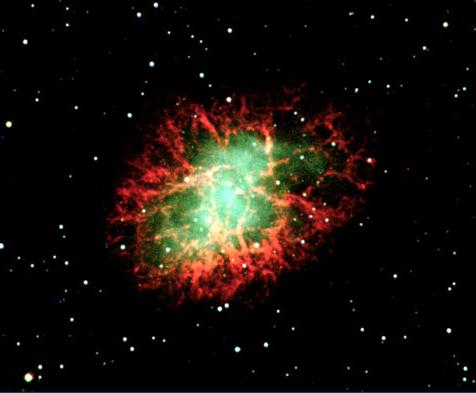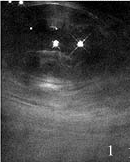Part II: Physical Processes in the Crab
 Astronomers use various filters designed to admit light of closely defined color. For example, if one wanted to isolate the emission due to hydrogen in its excited state, especially H
Astronomers use various filters designed to admit light of closely defined color. For example, if one wanted to isolate the emission due to hydrogen in its excited state, especially H at 656.2 nm, a red filter that blocked all wavelengths except those between 655.2 and 657.2 nm might be used. In this way, different features of the tangled gas of the nebula can be isolated and studied. As far back as the 1930's, astronomers identified two physically distinct regions: one, an amorphous oval-shaped distribution of gas; the other, a chaotic network of filaments. The optical spectrum of the nebula also shows two components: a continuous spectrum arising from the gas, with a spectrum of bright lines from the filaments superimposed.
at 656.2 nm, a red filter that blocked all wavelengths except those between 655.2 and 657.2 nm might be used. In this way, different features of the tangled gas of the nebula can be isolated and studied. As far back as the 1930's, astronomers identified two physically distinct regions: one, an amorphous oval-shaped distribution of gas; the other, a chaotic network of filaments. The optical spectrum of the nebula also shows two components: a continuous spectrum arising from the gas, with a spectrum of bright lines from the filaments superimposed.
The actual source of the blue/green continuous spectrum baffled astronomers for many years. Inspired by the challenge presented by the Crab, a Soviet astrophysicist suggested that the continuum light came not from electron transitions as in ordinary atoms, but instead from electrons moving through an extremely strong magnetic field. The electrons spiral endlessly in this field, and as they are accelerated emit "synchrotron light."
In the 1950's, radio astronomers had mapped a number of radio sources and detected the radio emission produced by slower-moving electrons.
The reddish and yellow filaments have been identified as expanding gases, consisting of the matter that was ejected by the supernova explosion seen over 900 years ago. The nebula was imaged through different filters and show the elements oxygen (green, wavelength = 500.7 nm), and hydrogen (red, wavelength = 656.2 nm, H ).
).
The view of the Crab at two additional wavelengths, infrared and radio, reveals even more information. Some of the infrared radiation comes from dust grains mixed in with the hot gas in the filaments. There is more dust in the nebula than scientists previously thought.

Recent observations of the Crab by the HST have detected rapidly-changing wisps of material. Although the HST obtained truly dramatic close-ups of the inner activity of the Crab, changing wisps of material were noted in observations taken in the 1960's. Is something rippling out from the center at speeds approaching the speed of light? Or are compression waves moving out and squeezing material in its path?
Not-so-subtle changes are noted in this
series of images taken by the Hubble Space Telescope. These include wisp-like structures that move outward away from the pulsar at half the speed of light, as well as a mysterious "halo" which remains stationary, but grows brighter then fainter over time. Also seen are the effects of two polar jets that move out along the rotation axis of the pulsar. The most dynamic feature seen, a small "knot," is actually a shock front in one of these polar jets.
 Astronomers use various filters designed to admit light of closely defined color. For example, if one wanted to isolate the emission due to hydrogen in its excited state, especially H
Astronomers use various filters designed to admit light of closely defined color. For example, if one wanted to isolate the emission due to hydrogen in its excited state, especially H Astronomers use various filters designed to admit light of closely defined color. For example, if one wanted to isolate the emission due to hydrogen in its excited state, especially H
Astronomers use various filters designed to admit light of closely defined color. For example, if one wanted to isolate the emission due to hydrogen in its excited state, especially H![]() at 656.2 nm, a red filter that blocked all wavelengths except those between 655.2 and 657.2 nm might be used. In this way, different features of the tangled gas of the nebula can be isolated and studied. As far back as the 1930's, astronomers identified two physically distinct regions: one, an amorphous oval-shaped distribution of gas; the other, a chaotic network of filaments. The optical spectrum of the nebula also shows two components: a continuous spectrum arising from the gas, with a spectrum of bright lines from the filaments superimposed.
at 656.2 nm, a red filter that blocked all wavelengths except those between 655.2 and 657.2 nm might be used. In this way, different features of the tangled gas of the nebula can be isolated and studied. As far back as the 1930's, astronomers identified two physically distinct regions: one, an amorphous oval-shaped distribution of gas; the other, a chaotic network of filaments. The optical spectrum of the nebula also shows two components: a continuous spectrum arising from the gas, with a spectrum of bright lines from the filaments superimposed.
